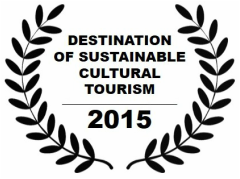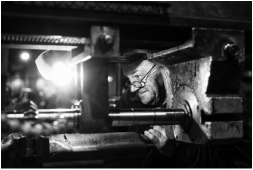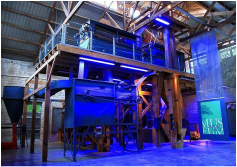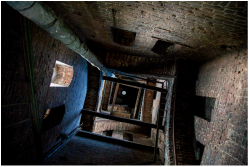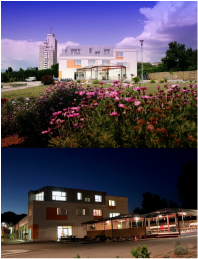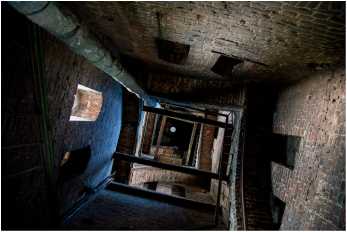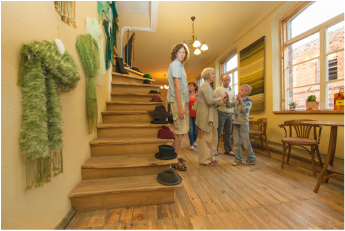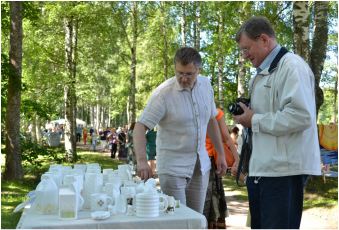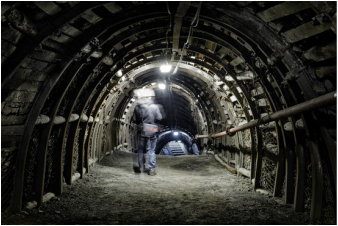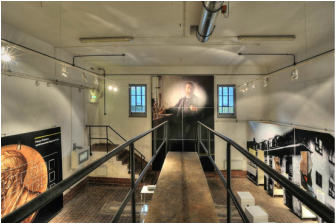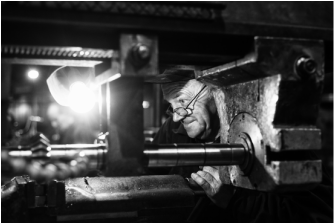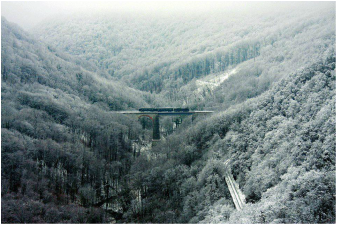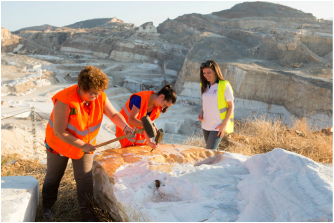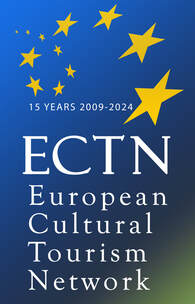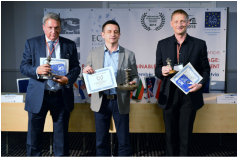
Awards for ‘Destination of Sustainable Cultural Tourism 2015’ go to Poland, Cyprus and Latvia
Cultural and heritage tourism is the fastest growing sector of European tourism and can contribute to the sustainability and competitiveness of tourism in the European Union.
European Cultural Tourism Network (ECTN) has initiated the only award in cultural tourism across Europe for nomination ‘Destination of Sustainable Cultural Tourism’ Award to tourism destinations Europe-wide for the benefit of destinations, communities, businesses, citizens and visitors.
The Theme for 2015 was ‘Industrial Heritage Tourism’ concerning results of actions which have been implemented and have produced significant results and achievements by destinations with a focus on local, regional, state or European context.
The winners of the ECTN Award 2015 on the theme ‘Industrial Heritage Tourism’ were announced at the Award ceremony during the international conference “Industrial Heritage: Prospects for Sustainable Tourism Development in Europe” on 18 September 2015, which was organised in Riga, Latvia.
During the ceremony, the three winners, selected by a Panel of Judges among all candidates were announced, honoured with Award ‘Destination of Sustainable Cultural Tourism 2015’ and received special prize, certificate and sign by E-FAITH.
The three winners are:
1st prize: Bydgoszcz Water, Industry and Craft Trail TeH2O in Poland
TeH2O: Bydgoszcz Water, Industry and Craft Trail was created in 2014 within a European Union project called SHIFT-X that aimed at bringing back the glamour and knowledge of the past industries. TeH2O is an industrial thematic trail that unites the history of 15 organically water-centred places in Bydgoszcz which unites the tales of the Bydgoszcz craftsmen, entrepreneurs and city activists.
2nd prize: Limassol Carob Mill and Warehouse in Cyprus
The Carob Mill Complex which is located next to Limassol’s Medieval Castle was originally built in the late 1800’s and was used as a warehouse. In the late 1920’s it was converted into a carob mill where carobs were processed. Carobs were used primarily in the manufacture of film, medicines, honey, chocolate etc. When the ingredients of carobs were no longer needed for the manufacture of these products, the carob mill was converted into a warehouse for fertilizers in the late 1960 and was used as such until the year 2000. Most of the machinery used for the processing of carobs are still intact and constitute a major attraction for the tourist and local population.
3rd prize: Daugavpils Shot Factory in Latvia
Daugavpils Shot factory is one of the oldest industrial enterprises in the territory of Latvia and one among oldest ammunition factories in Northern Europe founded in 1885. During 2014 historical part of the Factory was investigated by the State Inspection for Heritage Protection of Latvia and it was recognized as National Industrial heritage monument, being one of just 13 in Latvia.
The next ECTN Award contest for destinations will be announced in March 2016 on different topic and Award ceremony will take a place in Guimaraes – European Capital of Culture 2012 in Portugal during the 9th annual international conference in September 2016.
Press Release
Award Candidates
This list is published with permission of Applicant
© Description and photo provided by Applicant
|
Hostel Dharma and Yoga in Daily Life Culture Hall. Revitalization of ex-industrial industrial complex
Rijeka, Primorsko-Goranska county ‘Dharma’ means relation between human and nature in which human is protecting nature and nature is protecting human, a concept that can be identified as one of the oldest definitions of sustainable development. Hostel Dharma and Culture Hall are the partners in a project of urban, architectural and social implications, taking advantage of a new type of business in which profit and non-profit features are intertwined together enabling creativity and sustainability led entrepreneurship. This project redevelops the former “Plumbum - Vulkan” building in Rijeka – a former industrial hall with office spaces – and reuses it for the purposes of a Cultural hall and hostel. The building is located on the most prominent spot over the Eastern entrance of the city at the border of a still active industrial complex, which started a slow process of redevelopment, thanks also to this and similar initiatives. |
CROATIA
LATVIA
|
Daugavpils Shot Factory
Daugavpils, Latagale region Daugavpils shot factory is the oldest ammunition factory in Northern Europe operating since 1885. The Factory's shot tower is one of the best survived examples in the world and even today is producing lead shots. This lead shot making technology was invented by British plumber William Watts in 1782. By this technology the molten lead falls from the top of tower through a metal sieve, during a free-fall the lead freezes into spherical balls which are caught into a water basin. The Factory's tower is 30 m high and it has 19 m deep well under it, in addition to the tower there is a fully equipped shot after-processing department. According to the sustainable tourism development and industrial heritage preservation the Factory is open to tourists all year round with guided tours, the shot tower and the well under it was included in Latvian National Cultural Heritage Register in 2014 as the only such kind object in the Baltic states. |
|
Think Globally, Act Locally. Volunteering- Key to Renaissance of Limbaži Felt.
Limbazi, Vidzeme region Limbaži felt factory (during it’s best times called also Chapellerie et Filature de Lemsal) was the oldest and largest industrial company in the Hanseatic Town of Limbaži. The project proposal is about one part of Limbaži Felt factory that nowadays is managed by the local non governmental organization (NGO) “Limbaži Felt”. In the very beginning (at 25th of May Year 2009) it was a dream of small group of like-minded people to build an environment in which to fulfill and implement the activities what where not available in the town, where everyone can creatively ensure growth of personality. Nowadays it’s very well runned by NGO and is full of different aged people as activities are based on local needs and society request. In frame of Europe the good example is the power of local volunteers and NGO that was able to attract local, regional, national and European Union funds in order to keep as much historical evidences in the building as possible and to give spirit to abandoned industrial heritage. |
|
Piebalga Porcelain Factory
Vecpiebalga county, Vidzeme region Piebalga Porcelain Factory is an outstanding example of how the company's systematic and successful development contributes greatly to the local economy and self-esteem of the population. The only porcelain factory in Latvia produces unique and innovative handmade porcelain crockery and objects of art. The company employs local county residents only. Piebalga Porcelain Factory actively participates in various craft fairs and creates souvenirs based on customers’ design, which promotes local cultural heritage and scenic landscapes of Piebalga district. Piebalga Porcelain Factory is an example of sustainable and responsible tourism, which can be seen in the various areas. For example, employment of the local population, promoting Piebalga district by producing goods representing the district and attracting an increasing number of tourists that leads to economic development and preservation of cultural heritage. |
POLAND
|
Guido Mine extract attractions
Guideo Mine, Upper Silesia region The Guido mine is the only hard coal mine of this kind, where one can descend underground and find out how the underground miners work. There is no other monument of technology similar to the Guido mine in the whole of Europe! The mine was founded in 1855 by count Guido Henckel von Donnersmarck and was named after him. Coal extraction ceased here in 1928, later the mine was turned into the Experimental Mine M 300. In 2007 the undergrounds of the Guido Mine were opened for tourists as the independent cultural institution. Today in the Guido Mine, instead of coal seams, culture, tourism and entertainment are extracted – on the levels of 170 and 320 a plenty of attractions await tourists, attractions that cannot be seen anywhere else. To find out how the miners work used to look like, learn about the history of mining and its contemporary face, just put a helmet on, get a mining lamp and set off on a journey towards the underground adventure! It is worth remembering to greet each miner met underground with the traditional “God bless you!” |
|
The Old Mine Art and Science Center in Walbrzych
Walbrzych, Lower Silesia region The Old Mine Science and Art Centre in Wałbrzych in south-west Poland, is one of the most unique places in Europe. The mine was established in 18th century and the extraction of coal was stopped in 1996. Industrial architecture located in the mine is unique in the scale of Europe and worldwide. 2014 was the opening year of modern Centre of Science and Arts at the territory of eleven renovated buildings. An unique place of tourism, culture, arts, learning and education was formed in the strict centre of once industrial Wałbrzych. It is a major attraction in town and region, both for domestic and foreign guests. The Old Mine Science and Art Centre in Wałbrzych is an Anchor Point at the European Route of Industrial Heritage. Old Mine Science and Art Centre offers museum, Gallery of Arts and exhibitions, workshops and events. |
|
Exploseum – DAG Fabrik Bromberg war technology center
Kujawsko-Pomorskie Voivodeship Exploseum, part of Leon Wyczółkowski District Museum in Bydgoszcz, have a unique historical, touristic and educational value. The complex includes the original architectural structure and historical objects. We can see all these attractions, walking the 2 km long, tourist route leading in the ground and underground concrete tunnels of the old production line, still preserved since the Second World War. Multi-threading exhibition tells the story of the creation of the DAG trust in the world, about the people who worked in factories, as well as the story of Alfred Nobel, the inventor of dynamite and the founder of DAG. Visitors also have the opportunity to learn about weapons history from melee weapons to the times of nuclear weapons, as well as the history of explosives. Climate and unusual arrangement of this place makes Exploseum one of the most interesting tourist attractions in Kujawsko-Pomorskie Voivodeship and also in Poland. Exploseum is a part of ERIH – European Route of Industrial Heritage. |
|
Bydgoszcz Water, Industry and Craft trail TeH2O
Bydgoszcz, Kujawsko-Pomorskie region TeH2O: Bydgoszcz Water, Industry and Craft Trail was created in 2014 within a European Union project called SHIFT-X that aimed at bringing back the glamour and knowledge of the past industries. TeH2O is an industrial thematic trail that unites the history of 15 organically water-centred places in Bydgoszcz. Each story unites the tales of the Bydgoszcz craftsmen, entrepreneurs and city activists with the city growth. The city potential is always brought up by its people. The name of the Trail - TeH2O – accentuates T as in technology, H as in History and O as in Opening Up for the Past (to a T). The taming of water as an element forms the phenomenon of the Bydgoszcz industrial heritage. Bydgoszcz is a city on the water, a city of the water with its transportation route, a city of water with the energy source, a city of the water with the component in the production process. As a flagship of Bydgoszcz’s tourism, the industrial heritage meets the goals: raising awareness of Bydgoszcz as an attractive destination for industrial tourism and increasing the pride of residents in the holistic role of their city in the history of Poland and Europe. |
ROMANIA
|
Oravita Anina heritage train line
Caras-Severin region The place’s great history, reaching back to the Austrian empire makes it famous for its architecture and industrial activities. This train line is 33.4 km long, with 14 tunnels(2084m) and 10 viaducts (843m), being the oldest such building in Romania(1861-3). The region’s industrial patrimony also connects an amazing history, numerous monuments belonging to the extractive, transport, energetic and coal industries. This land where the magical train crosses for centuries valleys, rivers, mountains, meadows and rich beech and fir-trees forests also boasts other tourist attractions, such as: the Baile Herculane spa resort (visited and appreciated by Duchess Elisabeth Amalie Eugenie, known as Empress Sissi), Castellum Cornuţel, Clisura Dunarii, Nerei Gauge, Garana Jazz Festival, the Iron Gates Region Museum and the extraordinary Retezat National Park; besides these - many protected areas that could host all visitors interested in ecological tourism (wood cycling, bird watching, eco-fishing, zip-line flying, mountain hiking, belle époque train trips, photography) and in research-science study work. |
SPAIN
|
Development of the Municipality of Macael as a tourist destination created around the Marble
Macael, Andalusia region Macael Tourism is an industrial tourism development project around the marble, with which it aims to transform Macael to an "open museum", full of attractions that experience, understand and enjoy the Culture of Marble in Macael. As well as becomes a promotional tool of the industry itself, contributing to its sustainable development. It bases its action on a strategic plan whose axes are the networking of actors involved in the destination, the definition of an articulated and easily accessible tourist product, to make an experiential destination, to reinforce the aspects related to learning, achievement synergies with other destinations, and positioning Macael image as a tourist destination. |
About ECTN Award 2015
Culture and Heritage are important factors for sustainable development; contributing to the protection of natural and cultural heritage, the extension of tourism period as well as increase awareness of tourists and host communities, regional GDP and multiplier effects.
The development and protection of culture, heritage and development of sustainable tourism strategies are of added-value to regions and Europe-wide.
European Cultural Tourism Network (ECTN) has opened a contest for nomination ‘Destination of Sustainable Cultural Tourism 2015’ Award to all tourism destinations Europe-wide for the benefit of destinations, communities, businesses, citizens and visitors.
Theme for 2015 is ‘Industrial Heritage Tourism’ concerning results of actions which have been implemented and which have produced significant results and achievements by destinations with a focus on local, regional, state or European context related to:
- Old factories and equipment
- Mining sites
- Reuse of industrial buildings for cultural, leisure, educational and tourism purposes
- Power stations
- Industrial history museums
- Railway heritage
- Military installations
- Agricultural traditional tools and processes
- Maritime Heritage
- Canals and waterways
- etc.
Winners will be recognised as examples of excellence inspiring other tourism destinations and stimulating further development of regional initiatives.
One overall winner and two runners-up will be awarded.
The Winners will be announced at the Award ceremony and receive the Awards during the international conference “Industrial Heritage: Prospects for Sustainable Tourism Development in Europe”, to be held on 18 – 19 September 2015 in Riga, Latvia, all candidates will be invited.
Materials submitted will be promoted with acknowledgement to the Applicant at our website and announced in social media.
Applications will be evaluated by the special Award Commission (panel of judges) consisted of the experts from various countries. The Award Commission will assess the quality of all applications according following five criteria: technical content of actions, evidence of success, sustainability of the actions; added value to Regional policies for Tourism Sustainability and contribution to Europe 2020 targets.
As this is an international panel of judges, Applications must be submitted in English.
Guidelines and Application form:
| ectn_award_2015_description_final_31-07-2015.pdf | |
| File Size: | 708 kb |
| File Type: | |
| ectn_award_2015_application_form_v1.doc | |
| File Size: | 302 kb |
| File Type: | doc |
Detailed instructions on how to fill in the application form are provided in the application form itself.
Media contacts: Ieva Treija, Coordinator of ECTN, e-mail: [email protected]
Media contacts: Ieva Treija, Coordinator of ECTN, e-mail: [email protected]
ECTN Award
The Sustainable Cultural Tourism Award has been initiated by CHARTS project, co-financed by the European Regional Development Fund and made possible by the EU INTERREG IVC programme in 2014. It was agreed, that ECTN will take it over in the future in order to continue competition between destinations for Cultural Tourism Development and Promotion.
For more information including past winners, candidates and photo gallery, please, visit http://www.charts-interreg4c.eu/events/charts-award-2014/
The ECTN Award is based on a contest around annual theme for the benefit of destinations, communities, businesses, citizens and visitors to be launched annually on the different topics.
The theme for 2015 ‘Industrial Heritage Tourism’ has been linked with the Campaign for a ‘European Industrial and Technical Heritage Year 2015’, launched at the Start meeting on 6 March 2015, organised by the European Federation of Associations of Industrial and Technical Heritage (E-FAITH) at the Committee of the Regions in Brussels.
The ECTN Award is aimed at tourism destinations Europe-wide, for achievements of results and outputs on cultural tourism.
The Sustainable Cultural Tourism Award has been initiated by CHARTS project, co-financed by the European Regional Development Fund and made possible by the EU INTERREG IVC programme in 2014. It was agreed, that ECTN will take it over in the future in order to continue competition between destinations for Cultural Tourism Development and Promotion.
For more information including past winners, candidates and photo gallery, please, visit http://www.charts-interreg4c.eu/events/charts-award-2014/
The ECTN Award is based on a contest around annual theme for the benefit of destinations, communities, businesses, citizens and visitors to be launched annually on the different topics.
The theme for 2015 ‘Industrial Heritage Tourism’ has been linked with the Campaign for a ‘European Industrial and Technical Heritage Year 2015’, launched at the Start meeting on 6 March 2015, organised by the European Federation of Associations of Industrial and Technical Heritage (E-FAITH) at the Committee of the Regions in Brussels.
The ECTN Award is aimed at tourism destinations Europe-wide, for achievements of results and outputs on cultural tourism.

